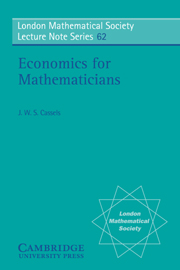Book contents
- Frontmatter
- Contents
- Preface
- Notation
- Chapter 1 UTILITY, INDIFFERENCE SURFACES
- Chapter 2 PURE EXCHANGE ECONOMY
- Chapter 3 THEORY OF THE FIRM
- Chapter 4 WELFARE ECONOMICS
- Chapter 5 LINEAR ECONOMIC MODELS
- Chapter 6 SIMPLE MACROECONOMIC MODELS
- Appendix A CONVEX SETS
- Appendix B THE BROUWER FIXED POINT THEORSM
- Appendix C NON-NEGATIVE MATRICES
- Index
Chapter 6 - SIMPLE MACROECONOMIC MODELS
Published online by Cambridge University Press: 03 May 2010
- Frontmatter
- Contents
- Preface
- Notation
- Chapter 1 UTILITY, INDIFFERENCE SURFACES
- Chapter 2 PURE EXCHANGE ECONOMY
- Chapter 3 THEORY OF THE FIRM
- Chapter 4 WELFARE ECONOMICS
- Chapter 5 LINEAR ECONOMIC MODELS
- Chapter 6 SIMPLE MACROECONOMIC MODELS
- Appendix A CONVEX SETS
- Appendix B THE BROUWER FIXED POINT THEORSM
- Appendix C NON-NEGATIVE MATRICES
- Index
Summary
Introduction
Macroeconomic theory considers the working of the economy as a whole, and deals in large aggregates such as “total income”, “total demand”, “saving”, “investment” and the like. It is not always clear exactly what these terms mean, even less how they should be measured in any given situation; and different economists have taken different interpretations. We shall adopt the eminently respectable tradition of pushing these difficulties to one side.
One must consider the ways in which these large aggregates affect each other. It is almost certainly true that everything affects everything else. We shall single out the influences we treat as important, and ignore the others. Economists of different epochs or of different schools have considered different influences to be the important ones, and so arrived at radically different theories: there is less concensus in macro-economics than in microeconomics. We shall follow the paradigm of Samuelson's Economics, itself based on the ideas of Keynes. We start from simple models and work up to more sophisticated ones, sometimes modifying (or even abandoning) hypotheses made earlier.
Some classical economists have asserted that “money is a veil”, i.e. that it obscures our view, but does not affect the workings, of the “real economy”. Hitherto we have indeed treated prices only as constructs which facilitate the mathematical treatment of the “real economy”. We shall now have to consider the interaction of the monetary with the “real” economy.
- Type
- Chapter
- Information
- Economics for Mathematicians , pp. 98 - 119Publisher: Cambridge University PressPrint publication year: 1981



